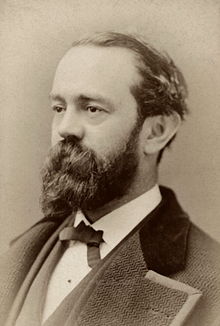Henry Draper
Henry Draper (born March 7, 1837 in Prince Edward County , Virginia , † November 20, 1882 in New York City ) was an American physiologist and astronomer . He was a pioneer in spectroscopy and the namesake for the Henry Draper catalog .
Life
As a boy, Draper helped his father ( John William Draper ) take photos of microscopic slides for a textbook. He studied medicine and in 1861 became professor of physiology and analytical chemistry at New York University . In 1867 he married Mary Anna, b. Palmer.
Since early youth he had astronomy as a hobby and became one of the pioneers of astrophotography and spectrography . In 1857 he visited Lord Rosse's private observatory in Ireland on a trip to Europe with the 72-inch telescope . The following year he began to manufacture a mirror telescope with a diameter of 40 cm, specially designed for sky photography . This development work in a private observatory on his father's property was carried out with the support of his brother Daniel . His detailed description of the manufacture of optics (a silver-plated glass mirror) and mounting was published by the Smithsonian Institution in 1865 and became a standard work for opticians . In 1870, Draper built an even larger telescope.
After a hunting trip to the Rocky Mountains , on which he caught a cold, he suddenly died at the height of his career.
Achievements as an astronomer
In addition to his - very successful - full-time occupation as a physiologist, he achieved groundbreaking achievements as an astronomer:
In 1872 he was the first to successfully photograph the spectrum of a star , the Vega (Alpha Lyrae). On the night of September 30, 1880 , he was the first to succeed in photographing a star nebula ( Orion Nebula ). He also designed the grating spectrograph . Draper was also able to detect the element hydrogen on the sun .
Other first achievements concerned the spectrogram of a comet and a wide-angle view of the entire comet's tail (Comet Tebbutt from 1881), also spectrograms of the moon and the planets Venus, Mars and Jupiter and finally of the Orion nebula. The mechanism for tracking the telescope, which was driven by a mechanical clockwork at the time , was decisively improved by him. This made it possible to take pictures of the sky with exposure times of over three hours. He also published monographs on spectrography and telescope constructions in specialist journals.
His widow donated the Harvard Observatory a considerable part of her inheritance ("Henry Draper Memorial Fund"). This was used to finance the publication of an extensive star catalog (nine volumes, 1918–1925). This was created by Annie Cannon and Edward C. Pickering and lists over 350,000 stars with their spectral classes .
The "Draper Classification" of the star spectra , the Henry Draper catalog , the Henry Draper Medal for special achievements in the field of astrophysics and the Draper lunar crater are named after Draper . In 1877 the National Academy of Sciences and the American Philosophical Society elected him a member. In 1881 he was accepted into the American Academy of Arts and Sciences .
Web links
- Publications by H. Draper in the Astrophysics Data System
- NN: Professor Henry Draper. Sidereal Messenger, vol. 1 (1883), pp. 258-259. (Obituary, English)
Individual evidence
- ^ Member History: Henry Draper. American Philosophical Society, accessed July 22, 2018 .
- ^ Members of the American Academy. Listed by election year, 1850-1899 ( [1] ). Page 7. Retrieved September 22, 2015
| personal data | |
|---|---|
| SURNAME | Draper, Henry |
| BRIEF DESCRIPTION | American physiologist and astronomer |
| DATE OF BIRTH | March 7, 1837 |
| PLACE OF BIRTH | Prince Edward County , Virginia |
| DATE OF DEATH | November 20, 1882 |
| Place of death | New York City |

